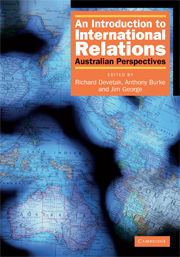Book contents
- Frontmatter
- Contents
- List of tables, figures and boxes
- List of contributors
- Preface and acknowledgments
- An introduction to international relations: the origins and changing agendas of a discipline
- 1 Theory and practice in Australian international relations: the search for identity and security
- Part 1 Theories of international relations
- 2 International relations theory in an era of critical diversity
- 3 Liberalism
- 4 Realism
- 5 Marxism
- 6 Feminism
- 7 Postmodernism
- 8 Constructivism and critical theory
- 9 Global justice and cosmopolitan democracy
- Part 2 The traditional agenda: states, war and law
- Part 3 The new agenda: globalisation and global governance
- Glossary of terms
- Bibliography
- Index
- References
2 - International relations theory in an era of critical diversity
from Part 1 - Theories of international relations
- Frontmatter
- Contents
- List of tables, figures and boxes
- List of contributors
- Preface and acknowledgments
- An introduction to international relations: the origins and changing agendas of a discipline
- 1 Theory and practice in Australian international relations: the search for identity and security
- Part 1 Theories of international relations
- 2 International relations theory in an era of critical diversity
- 3 Liberalism
- 4 Realism
- 5 Marxism
- 6 Feminism
- 7 Postmodernism
- 8 Constructivism and critical theory
- 9 Global justice and cosmopolitan democracy
- Part 2 The traditional agenda: states, war and law
- Part 3 The new agenda: globalisation and global governance
- Glossary of terms
- Bibliography
- Index
- References
Summary
Introduction
This chapter introduces the range of theoretical perspectives and issues that have animated the study of international relations in Australia and abroad. First, it explains why theoretical reflection is indispensable to explaining and understanding international relations. Second, it addresses unavoidable ontological and epistemological issues in the quest for theoretical understanding. Third, it traces the growth of mainstream international relations theory. Fourth, it analyses the rise of diverse critical approaches to the study of international relations. Finally, it maps the developments of international relations theory in Australia.
The necessity of theory
Students in International Relations are often wary of ‘doing’ theory. Sometimes they are frightened of it, sometimes hostile to it. The reasons for these attitudes vary. Theory, it is often proclaimed, is too difficult, too abstract or irrelevant to the real world. Thankfully, these attitudes are changing as International Relations students become more aware of sophisticated debates about the nature and role of theory in understanding and explaining the real world they speak of and live in. These debates illustrate that theorising is not something one can choose to avoid; that in the process of giving meaning to the things, peoples, events and controversies in the world, we are engaged in a theoretical process, explicitly or otherwise.
In particular, we cannot simply observe the everyday world of international relations without giving theoretical meaning to what we are seeing.
- Type
- Chapter
- Information
- An Introduction to International RelationsAustralian Perspectives, pp. 31 - 42Publisher: Cambridge University PressPrint publication year: 2007
References
- 3
- Cited by

